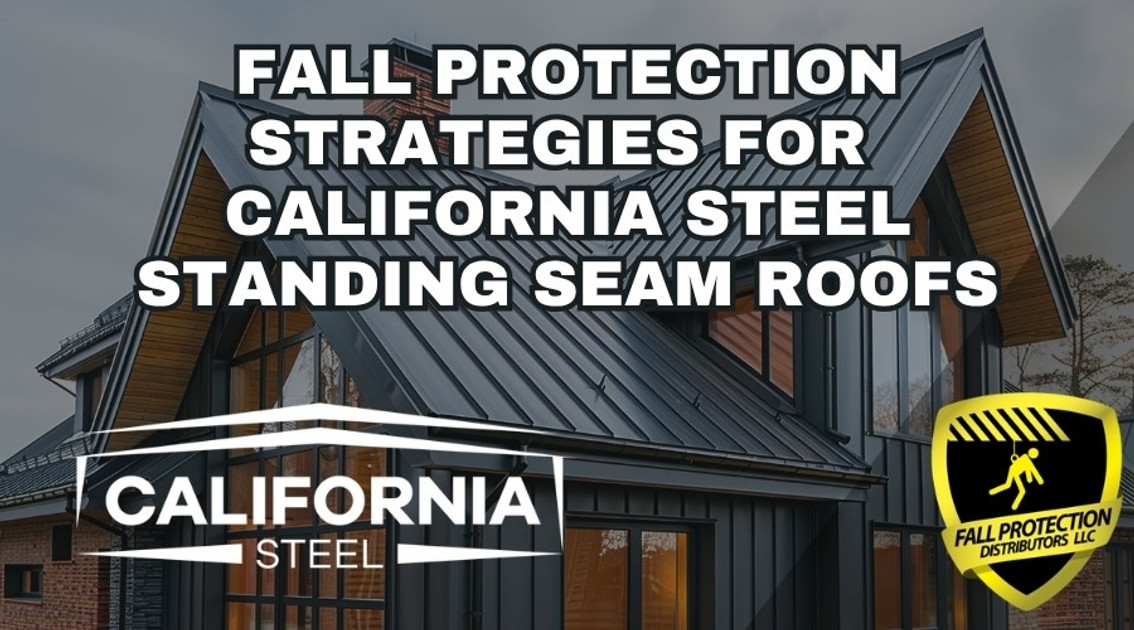Fall Protection Strategies for California Steel Roofing
Posted by Howie Scarboro - CEO Fall Protection Distributors, LLC on Oct 1st 2025
See the Roof Anchor Compatibility Chart for California Steel Roofing Standing Seam Panels.

Who Is California Steel Roofing?
Founded in 1974, California Steel began with a mission to deliver roofing and siding built for strength and longevity. In the early years, the focus was on supplying practical, weather-resistant materials for California's diverse climates, from coastal environments to inland heat. Over time, the company expanded its lineup while maintaining its focus on craftsmanship and dependable service.
Today, California Steel is a recognized leader in the steel panel market, providing solutions for residential, commercial, and agricultural projects alike. Their reputation for quality and integrity has stood the test of time, and many of their customers return project after project because of the trust they've built. California Steel continues to set itself apart with a wide range of customizable roofing and siding panels. Their materials are engineered for strength and weather resistance, giving customers confidence that their projects will last. They serve contractors, building professionals, and homeowners, always tailoring their solutions to the specific needs of each client.
One standout tool is their 3D panel designer, which allows customers to see exactly how different panels, colors, and styles will look before ordering. This type of innovation facilitates planning and ensures that the finished project aligns with the original vision. Beyond the products themselves, California Steel offers something equally important: personalized service. Their team provides expert advice at every stage of a project, helping customers choose the right panel profile, paint system, or trim option. Fast, reliable turnaround times and clear communication round out a customer experience that's as strong as their panels.
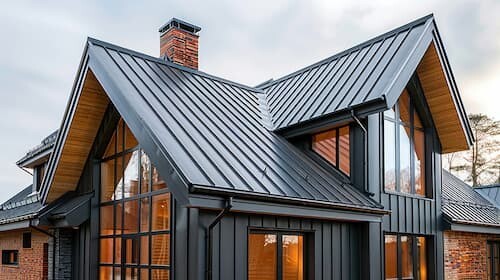
Why Are Compatible Fall Protection Anchors Important for Standing Seam Roofs?
Standing seam roofing is renowned for its sleek appearance, exceptional durability, and the ability to last for decades.
Using the wrong type of anchor on a standing seam roof can lead to problems that undo all the advantages of the system.
Drilling into seams or attaching anchors that crush the panels may compromise the watertight seal and void warranties. Leaks, structural damage, and costly repairs often follow. That's why compatible fall protection anchors are essential for standing seam roof systems.
Products like the SSRA1 Standing Seam Roof Anchor clamp directly to the seam without any penetrations, providing workers with a 5,000-pound-rated tie-off point while preserving the roof's integrity. Accessories like the SSRA2 Adjustable Roof Jack Adapters and SSRA3 Anchor Plates expand protection by supporting 10-foot wooden walkboards or 100-foot temporary lifelines.
For lighter-gauge panels that cannot handle seam clamping, the Ridge Pro Steep Assist offers an alternative. Installed over the ridge with a lightweight extension pole, it keeps workers tied off before stepping onto the roof. It maintains a 100% tie-off throughout the job.
The lesson is simple: roofing systems like those produced by California Steel perform best when paired with fall protection systems designed specifically for standing seam. Choosing the proper anchors protects workers from injuries and ensures the roof system remains watertight.
Striated Snaplock Standing Seam Panels
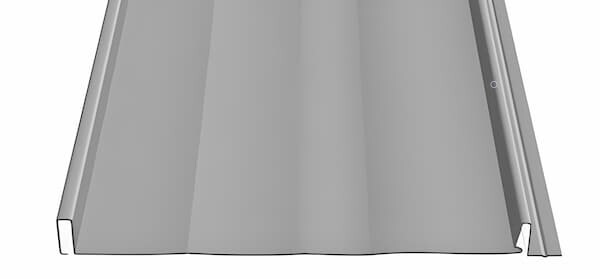
Striated standing seam panels deliver a modern and refined look with just the right amount of texture.
The subtle striations break up the flat surface of the panel, giving the roof a sleek yet visually dynamic finish. These panels are popular for residential, commercial, and architectural projects because they combine contemporary style with long-term strength. See the Roof Anchor Compatibility Chart for California Steel Roofing Striated Snaplock Standing Seam Panels.
Available in 12-inch and 16-inch coverage widths, the panels feature a one-inch rib height that improves rigidity and performance. They are manufactured in both 24-gauge and 26-gauge steel, offering options that meet various project requirements. Steel substrates feature premium finishes, including MS Colorfast45®, MS Crinkle Finish, PVDF/FEVE, and Acrylic Coated Galvalume. These coatings deliver long-lasting color retention, resist corrosion, and boost energy efficiency.
These panels utilize a concealed fastener system, resulting in a clean and sharp finished look. That hidden fastening also reduces potential leak points, ensuring durability for decades to come. Striated panels are easy to install, making them a strong choice for both new construction and reroofing projects where aesthetics and reliability are key considerations.
Fall Protection for Striated Snaplock Standing Seam Panels
For 24-gauge steel panels, contractors can safely use the complete SSRA product line.
The SSRA1 Seam Anchor provides a non-penetrating tie-off point rated to 5,000 pounds, giving workers OSHA-compliant fall protection without compromising the panel seams. Once you install the SSRA1 anchors, you can expand them with SSRA2 Adjustable Roof Jack Adapters that mount directly on top. This setup supports ten-foot wooden walkboards, creating stable platforms for roofers working on long or steep spans. You can add the SSRA3 Anchor Plate to convert the SSRA1 into a secure attachment point for temporary 100-foot horizontal lifelines. These lifelines connect multiple workers to a secure system, allowing safe mobility across the roof.
For long-term solutions, the Super Anchor 120-foot Standing Seam HLL Kit is available. This kit installs permanent galvanized steel cable lifelines across the standing seam roof without a single penetration, providing a ready-to-use safety system for maintenance crews or facilities with regular rooftop access.
Seam clamping is not recommended on lighter 26-gauge steel panels because the thinner substrate cannot withstand the pressure from anchor set screws. In these cases, the Ridge Pro Steep Assist is the ideal option for roofs with a pitch of 6:12 to 12:12. The Ridge Pro hooks over the peak of the roof and can be installed with a lightweight extension pole, allowing workers to tie off before stepping onto the panels. This feature ensures 100% tie-off from the ladder to the ridge and back down again, offering dependable protection without risking damage to the roof system.
Design Span HP Panels
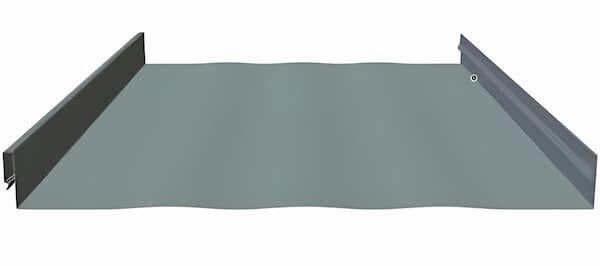
Design Span HP is ASC Building Products' flagship structural standing seam roof panel, engineered for high performance in residential, commercial, and institutional projects alike.
With its 1¾ inch seam and snap interlock system, this panel delivers strength and clean aesthetics without the need for field seaming. The concealed clip system allows for thermal movement and installation on slopes as low as 2:12, making it versatile across a wide range of roof designs. See the Roof Anchor Compatibility Chart for California Steel Roofing Design Span HP Standing Seam Panels.
Each panel undergoes rigorous testing for air infiltration (ASTM E1680), water infiltration (ASTM E1646), and wind uplift (ASTM E1592), proving its reliability under extreme weather conditions. When installed to UL requirements, it also carries a Class A fire rating, providing an additional layer of protection. The panel is available in 22-gauge and 24-gauge steel with coverage widths of 12, 16, 17, and 18 inches. Factory notching at the eave reduces labor during installation and provides a clean, finished appearance.
The Dura Tech 5000 and Dura Tech MX paint systems enhance durability with commercial-grade fluorocarbon finishes that resist fading and chalking in extreme environments. Customers can choose from a wide selection of energy-efficient colors, ensuring both long-lasting performance and design flexibility.
Fall Protection for Design Span HP Panels
For 22- and 24-gauge steel, the SSRA system offers a reliable, non-penetrating solution.
The SSRA1 Seam Anchor provides a secure 5,000-pound tie-off point without panel penetrations. Roofers can then expand the system with SSRA2 Adjustable Roof Jack Adapters, which mount directly on top of the anchors and support ten-foot wooden walkboards. These walkboards give crews a safe footing on steep or extended spans. Adding SSRA3 Anchor Plates transforms the SSRA1 into a mounting point for temporary horizontal lifelines, allowing for up to 100 feet of safe tie-off across the roof without requiring a single penetration.
For facilities that need long-term safety systems, the Super Anchor 120-foot Standing Seam HLL Kit is an excellent option. This permanent setup installs galvanized steel lifelines across the roof, offering continuous fall protection for maintenance or inspection crews.
Another dependable solution is the Ridge Pro Steep Assist. On roofs with slopes between 6:12 and 12:12, it installs directly over the ridge with a lightweight extension pole. This advantage keeps workers tied off before they step onto the panels, ensuring 100% tie-off from the ladder to the ridge and back down.
Skyline Roofing Panels
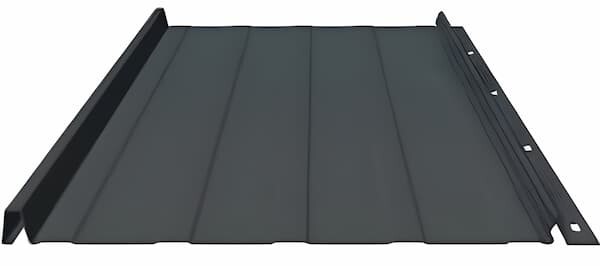
Skyline Metal Roofing offers a clean, modern look with performance that holds up for decades.
Manufactured from 26-gauge steel, these panels feature a one-inch rib height and come in 12-inch or 16-inch coverage widths. The snaplock design, featuring a pre-punched nailing flange, makes installation straightforward. It ensures the roof maintains its sleek appearance over time. See the Roof Anchor Compatibility Chart for California Steel Roofing Skyline Standing Seam Panels.
These panels work well on roof slopes as low as 3:12, giving builders flexibility for a wide range of projects. Homeowners often choose Skyline for its balance of style, durability, and cost. The DuraTech XL paint system is available in a variety of energy-efficient color options, many of which feature reflective pigments that help reduce heat absorption. With a limited lifetime warranty in residential applications, Skyline provides long-term value backed by proven performance.
Skyline panels are also tested and rated to meet Class A Fire requirements when installed on noncombustible decks, ensuring compliance with building codes like the IBC, IRC, CBC, and CRC. Beyond performance, the panels support sustainable building practices since steel is 100 percent recyclable at the end of its service life.
Fall Protection for Skyline Roofing Panels
Skyline panels use lighter 26-gauge steel, so seam-mounted anchors like the SSRA1 are not recommended.
The material does not provide the strength required for seam clamping under fall arrest loads. For this panel, the Ridge Pro Steep Assist stands out as the most effective option.
The Ridge Pro installs over the ridge using a lightweight extension pole. Hence, workers remain tied off before they ever step onto the panels. Once in place, it provides a secure tie-off point for slopes between 6:12 and 12:12. Crews can also pair it with a vertical lifeline kit, which includes a rope grab and shock pack, to maintain a 100 percent tie-off while moving along the roof. This setup provides peace of mind for both contractors and building owners, ensuring worker safety while preserving the integrity of the roof system.
Metal Roof Anchor Panel Compatibility For California Steel Roofing
| Striated Snaplock 24 ga. | Design Span HP 22 ga. | Design Span HP 24 ga. | Skyline 26 ga. | |
|---|---|---|---|---|
SSRA 1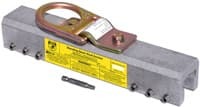 |
NO | YES | NO | NO |
SSRA1 Nylon Tip 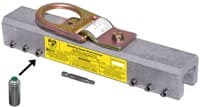 |
YES | YES | YES | NO |
SSRA2 Roof Jack 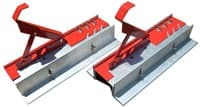 |
YES | YES | YES | NO |
SSRA3 Anchor Plate 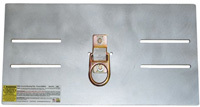 |
YES | YES | YES | NO |
The Ridge Pro 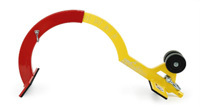 |
YES | YES | YES | YES |
Contact Us For More Information
For further details on roofing solutions and fall protection systems, please get in touch with us at 863-703-4522 or visit www.StandingSeamRoofAnchor.com. Let's work together to make your roofing projects safe, beautiful, and built to last. For more safety tips, refer to OSHA's 48-page Fall Protection Manual. Once you have determined the most suitable anchors for your roof system, download our free Anchor Inspection Form.
Safety Tips For Standing Seam Roofs
Promote a Culture of Safety
The best crews have one thing in common: they looked out for each other. Building a culture of safety isn't about checklists or rules—it's about creating trust. Discuss near misses openly, encourage your crew to report hazards, and make safety a part of the daily routine. When workers believe leadership takes safety seriously, they buy in, and that's when the real change happens.
Ensure Proper Footwear for Stability
A metal roof requires footwear with strong traction, firm ankle support, and comfort that lasts throughout the day. Proper shoes not only prevent accidents but also reduce fatigue, allowing for a sharper focus on the job. If there's one piece of gear people cut corners on, it's footwear—and that's a mistake you only realize once it's too late.
Use Specialized Anchor Systems for Standing Seam Roofs
Drilling through a seam to attach an anchor is the quickest way to ruin a standing seam roof. Standing seam panels shed water effectively but don't handle penetrations well. That's why seam-mounted anchors, like the SSRA1, matter. They clamp tight without leaving a hole behind, protecting both the worker and the roof system.
Prioritize Ladder Safety Training
Some of the nastiest falls never even reach the roof. They happen on ladders. Teaching your crew how to properly inspect, secure, and climb ladders might feel like a basic reminder. Still, it prevents injuries that sideline entire teams. Please stick to the 4-to-1 rule, maintain three points of contact, and make it a part of your muscle memory. A safe climb sets the tone for a safe day.
Consult Experts for Curved Metal Panels
Curved roofs are beautiful, but they can also be unpredictable. As the panels are bent, the mounting areas are no longer reliable. Hire a fall protection expert to determine the most effective fall protection plan for these types of roofs.
Encourage the Use of Trauma Straps
Stopping a fall is only half the battle. Trauma straps give a worker the ability to stand in their harness, relieve pressure, and hold out until help arrives. They're lightweight, inexpensive, and yet they might be the difference between a close call and a tragedy.
Install Permanent Roof Anchor Systems
If crews are repeatedly returning to the same roof, it makes sense to stop playing the temporary anchor game. Permanent systems get installed once and stay ready for every future visit, whether it's HVAC maintenance, solar installs, or inspections. It saves setup time, reduces mistakes, and gives building owners peace of mind knowing their roof and workers are protected every time someone works on it.
Equip Workers with High-Quality Safety Gear
You can't expect workers to take safety seriously if the gear you hand them is worn out or uncomfortable. A harness that fits right, lifelines that lock reliably, and SRLs that meet OSHA standards make all the difference. Crews are more likely to use their equipment properly when they trust it, and regular inspections should be second nature. Premium safety gear is an investment in your team's confidence as much as it is in their safety.
Set Up Protective Guardrail Barriers for Work Zones
Guardrails provide a simple solution, but many crews overlook them because they don't appear high-tech or flashy. Yet, they do something no harness can—they stop workers from getting near a fall hazard. On sites with skylights, roof edges, or crowded work zones, guardrails create clear, safe boundaries. They're a passive kind of protection, but in my experience, preventative solutions often save the most lives.
Develop OSHA-Compliant Safety Plans
Every job is different, and so is every safety plan. Write the plan down, update it regularly, and ensure that every crew member understands their role. It's not just about avoiding fines—it's about providing the team with a roadmap in place when conditions shift or emergencies arise. A good plan keeps everyone calm and focused when it matters most.
Disclaimer
The views, recommendations, and information presented in this blog are solely those of the author and do not necessarily reflect the opinions or positions of the featured panel manufacturer, its brands, subsidiaries, or parent companies. Customers are strongly encouraged to contact the roof panel manufacturer directly for inquiries regarding fall protection compatibility with their products and to address any potential warranty issues that may arise after installing our products.

